Table of Contents
Search engines have complex algorithms that analyze each web page for its relevance to searchers. These algorithms consider a number of data points and content characteristics, known as “SEO ranking factors” to decide which web pages users will see first. While there are many factors to take into account, there are a select few that have a much larger impact on your site’s overall performance.
What are SEO ranking factors?
SEO ranking factors are the criteria points that search engines use to determine where web pages will be displayed in search engine results pages (SERPs). Every search engine looks for different qualities in top-ranking content. These ranking factors determine how much organic search traffic your content receives.
The web pages shown on SERPs come from Google’s index. They are composed of all the pages that Googlebot (or “crawlers”) have analyzed and compiled for use.
When someone types in a search, Google refers back to its index and displays pages in order of their relevance and value to the user (based on SEO ranking factors). SEO is the process of making web pages more accessible and understandable to crawlers so they will rank higher in SERPs.

Higher rankings are correlated with more traffic and leads, so if you want more potential customers to visit your website, you should make sure your content satisfies SEO ranking factors.
However, not all ranking factors deserve the same amount of effort on your end. There are some factors that have a major impact on your rankings while others only account for a small portion of your overall score.
The most important SEO ranking factors
It’s highly unlikely that you have the resources or desire to target each of Google’s 200+ ranking factors. And even if you did, the amount of return you’d receive from those efforts would hardly be worthwhile.
Instead, optimize for the most important SEO ranking factors. These approaches encompass many of the top SEO techniques and strategies which improve websites’ overall position in SERPs. Narrowing your focus to these critical ranking factors can leave you with more time to develop content, generate new leads, and make sales.
High-quality content
Top-ranking web pages are filled with high-quality content that serves the user. Content marketing works best when you’re able to promote these types of pages. By creating content at the intersection of your business goals and customer searches, you can attract visitors that may have a need for your product via the SERPs.
To rank highly, web pages need to be both relevant and engaging. Each piece of content you create should provide users with the very information they’re searching for, an SEO strategy known as “satisfying user intent.”
There are four main reasons why your audience would look up a certain keyword:
- Navigational: They are trying to find a specific website or tool.
- Transactional: They are looking for a specific product or service to buy.
- Investigational: They are researching a product or service.
- Informational: They want to find information on a topic.
When you begin keyword research, take a look at the current search results. What format does the top post use? Do the current results lack a certain style or discussion of the topic? Google’s current rankings will give you the best insight into what content works best for your keywords.
The average top-ranking page has 2,416 words total. And that has less to do with an ideal word count and more to do with Google wanting search engine results to be comprehensive. More words mean more information for the earcher.

Depending on your target keywords, different format styles may work better. Consider the following result for “best craft ideas for kids:”
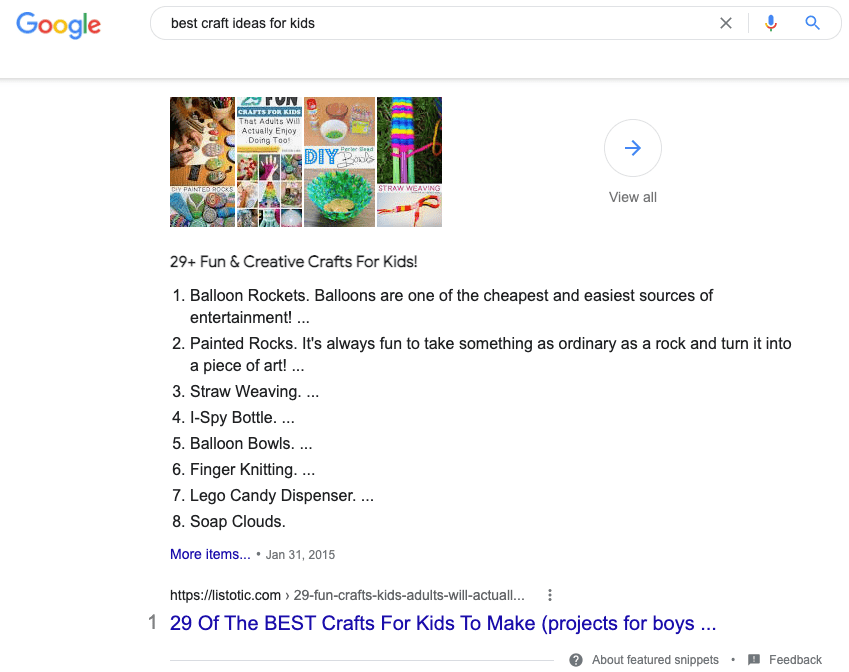
Google presented this result as a list because it gives users quick answers to their search query. The post was published in 2015 but still ranks on the first page due to its high-quality and timeless or “evergreen content.
Search engines display posts that give users the most updated information. In some industries, like fashion or home decor, you have to regularly publish content that reflects current trends. Search terms like “best summer shirt styles 2021” will decrease in popularity over time. Their subsequent content will need to be changed to reflect new trends in the coming fashion season.
As you develop SEO content, always keep the user at the center. Creating a web page requires an understanding of how search engines rank content and why users search for various results. The better your information, the more likely you are to score better against search engine algorithms’ ranking criteria.
Backlinks
When other domains refer their readers to your website’s content, this is called a “backlink.” SEO backlinks show up as hyperlinked text on a web page:

The linked page content, also known as the “anchor text,” plays a role in your SEO. Crawlers analyze the anchor text in backlinks to understand more about the content of the linked page. Improve the accuracy of external anchor text by making your target keywords obvious throughout your content. This increases the chances of Google ranking the page for the correct search terms.
Backlinks are considered one of the most important search engine ranking factors. This is because backlinks show Google that your content is reputable and trusted within your industry. If it wasn’t credible, why would other webmasters send users to your page?
Search engines look at both the quantity and quality of backlinks. Your goal should be to earn referrals from websites with high domain authority. For example, if you have a website about athletic apparel, a backlink from Nike’s blog would be really helpful. This would show the search engine that your information is credible within your industry. Having these referrals from well-known, trusted, high-traffic websites can ultimately increase your SEO visibility and lead to more traffic.
Building a backlink profile, or the sum total of all external links to your site, should be a top priority in your overall SEO strategy. Here are some of the best ways to get incoming links from other websites:
- Create interesting visuals that others can share.
- Have an active social media profile where people can interact with you.
- Write guest posts for other websites.
- Find broken links on other sites and contact the site owners to consider replacing the link with your own content.
- Use a backlink checker to ensure to find areas of opportunity.
- Publish case studies on your own brand’s research and successes.
These and other link building strategies can increase your brand awareness and reputability over time. Research has shown that having more backlinks correlates to better SEO ranking.
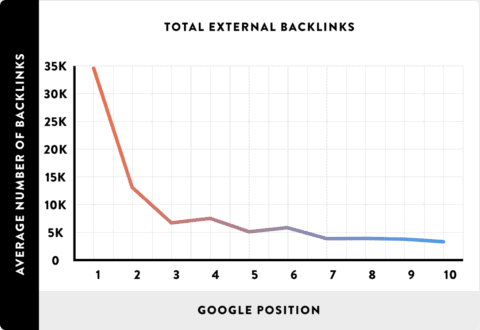
Focusing on how to earn referrals from other sites can expand your potential audience, as well. Take advantage of any opportunities you have to collaborate with reputable brands in your industry. This approach can have impactful returns on your SEO efforts without requiring a significant time investment.
Crawlability
Search engines have to find and crawl your pages in order to index them. Improving your page crawlability is fairly simple, but it can speed up the process and help you climb SERPs faster.
An XML sitemap, for example, is like a map to all the pages on your site. When you submit one of these through Google Search Console, you are essentially telling Google where it can find and crawl all your pages. This way, none get left out.
Also add a robots.txt file to your website if you need to give it specific directions on how to crawl specific web pages. For example, there may be some pages you want to leave out of search engine results, and the robots.txt file can tell Google to do this.
You may also have duplicate or unfinished content that you don’t want the search engine to see. When the search engine finds duplicate content, it won’t know how to crawl and index your page. This can result in both pages competing against each other for rankings, or one of the pages getting left out of the index, and if it’s not the one you want visitors to go to, you’re out of luck. Fortunately, there’s a way to avoid all this with the canonical tag.
Your Google Search Console dashboard will show you which pages on your website have already been crawled. If you notice that pages you published several months ago, you may have a technical error on your site. This can prevent crawlers from accessing your web pages, causing you to miss out on valuable search traffic.
Mobile-friendliness
For SEO purposes, the mobile version of your website is more important than the desktop version. Google has implemented a mobile-first indexing process. This means that information in its index comes directly from the smartphone and tablet versions of websites.
If you don’t have a mobile optimization strategy, your website may have a much lower ranking in the SERPs. Use Google’s free Mobile-Friendly Test to learn where your site needs improvements.
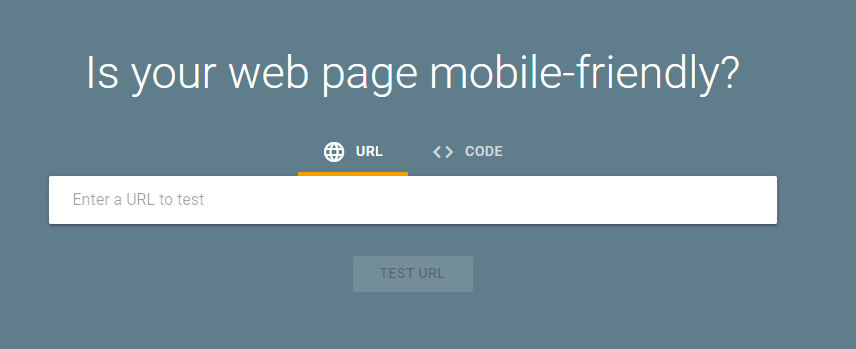
Once you know where the issues are, you can begin correcting them. There are many ways to optimize for mobile, but start by:
- Filling out your local SEO profiles
- Eliminating pop-ups
- Improving page speed
- Unblocking CSS and Javascript
- Using responsive design features on WordPress, Wix, etc.
- Writing shorter meta descriptions and title tags for mobile
- Making buttons and hyperlinks large enough for users to click on
The better your content is for mobile devices, the more valuable it will appear to the search engine. It’s estimated that by 2025, nearly 75% of internet users will use only their smartphones to access the web. Optimize ahead of time to ensure that your website doesn’t fall to the wayside as mobile websites take over search engine activity.
Page speed
A slow website can turn users away quickly. If people don’t stay long enough on your site, search engines won’t put it on the first results page. That’s why page speed is one of the top SEO ranking factors: It directly affects user experience.

Make your website faster by:
- Using CDN (content delivery networks) to store your web pages
- Minifying Javascript, HTML, and CSS code
- Doing image SEO to reduce loading time for graphics, charts, etc.
- Caching data on browsers like Chrome, Safari, and Firefox
- Implementing Google AMP (formerly known as accelerated mobile pages)
- Reducing the number of plugins you use
- Switching WordPress to PHP7
When search engines see that your website delivers instant, high-quality results, they will consider boosting its rankings. These strategies can make it easier for customers to find products and check out when they’re finished shopping, too. Increasing your chances for more sales.
Usability
User experience (UX) is the heart of SEO success. People need to be able to easily find and access the content on your website if they’re going to become customers or regular visitors.
This comes down to your overall web design. As you develop web pages, consider how they impact the overall user experience:
- Is the URL structure spammy or does it provide useful context?
- Do notifications and/or pop-ups block the content?
- How easy is it to find information within the text (navigation pane, sidebar menu, etc.)?
- Are there headers to organize the content?
- Is there alt text on images so that visually-impaired users can understand images?
- Do the internal links work?
- Are there an appropriate amount of images and do those images add value to the written content?
Implementing on-page SEO techniques ensures that your overall web design serves the user. Google uses metrics like bounce rate, dwell time, and CTR to understand a page’s quality. If your page is too cluttered and disorganized, it may turn users away and have a negative impact on your overall performance.
Local factors
Nearly half of all Google searches are for local information, meaning that small businesses can’t afford to be without an SEO strategy. Marketers for these businesses have some unique local SEO tactics to improve their rankings.

Local business owners should make sure they fill out their Google My Business (GMB) in its entirety. A GMB profile is a listing that includes all of your important business information. It’s where potential customers find your contact details, website, reviews, star ratings, directions, and more. Just over 1% of all search traffic comes from Google Maps, which equates to just over a billion searches per year.
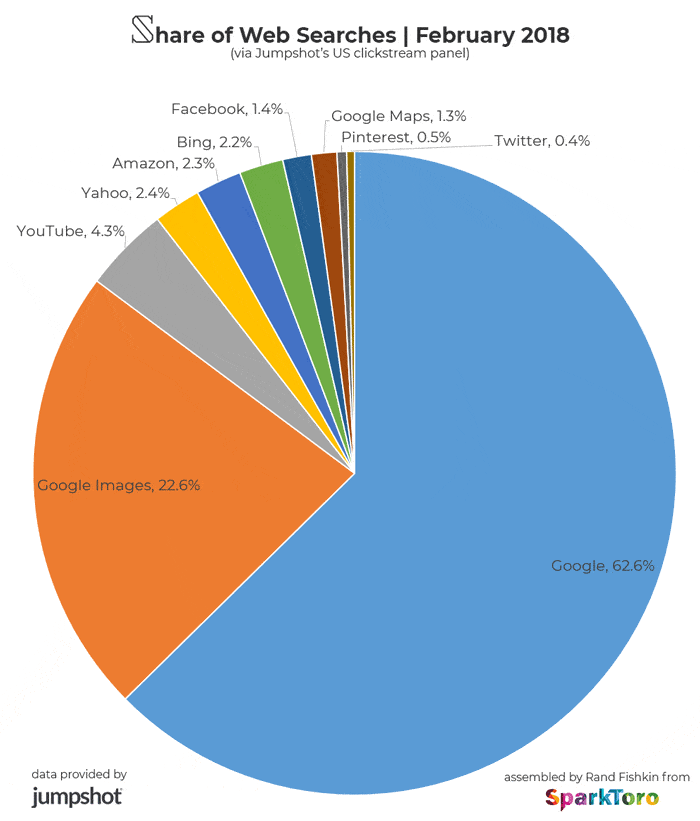
You should also set up your business profile on Bing Places and Apple Maps. Although they receive less traffic than Google’s service, people still use them to find shops in the local area.
Another local SEO technique to implement is NAP citation building. NAP (name, address, phone number) citations are business listings in online directories like Yelp, YellowPages, and other industry-specific guides. Having your contact information available across the web increases the chances of you earning in-store traffic from online searches.
Small business SEO also includes optimizing for long-tail target keywords. These types of keywords usually have lower search volume but higher conversion rates. Plus, pay-per-click (PPC) ad campaigns for these terms are usually less expensive.
Before you choose long-tail keywords, determine your ideal customer. What are they looking for and how can you provide it in a way that others can’t? Knowing this will help you choose long-tail keywords with the most potential for increased traffic.
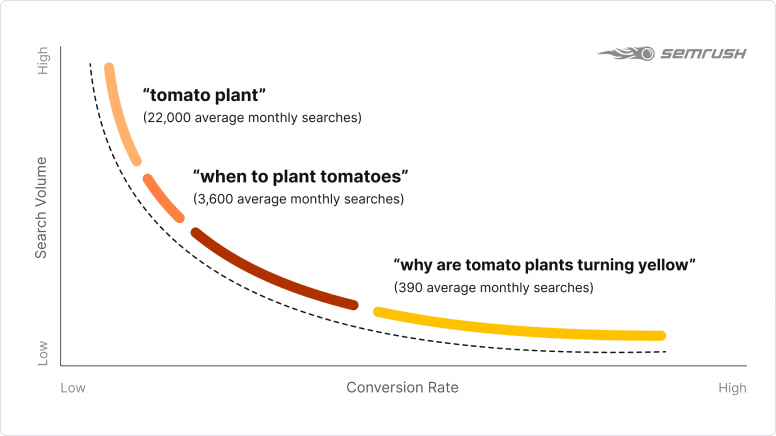
While long-tail keywords may seem more difficult to do SEO for, they represent more than half of all search queries. And with the continual rise of voice search, these keywords’ share of total searches may increase, as well. That’s because voice search queries are an average of three to four words longer than regular searches.

Other local SEO strategies for increased traffic include:
- Optimizing for local search terms (EX. “bike rentals in Portland”)
- Using schema markup to generate rich snippets
- Having a separate landing page for each physical store location
- Publishing customer reviews
- Adding local keywords to meta tags
- Optimizing your homepage for a target keyword
- Including a contact page on your website
Long-tail search terms offer a higher potential share of overall search volume because many businesses target the most obvious keyword phrases. These strategies can provide a major boost in traffic when you’re struggling to compete with larger businesses.
SEO ranking tools
In order to improve your rankings, you need to be able to track them first. There are many SEO tools that you can use to gauge whether your efforts are working. Here are some of the best resources for staying on top of your ranking metrics.
- Google Search Console: Track click-through rate (CTR) SEO performance, audit sitemap for issues, and explore new backlink opportunities.
- SE Ranking: Analyze keyword ranking on Google, Bing, Yahoo, YouTube, and Yandex.
- Serpstat: Monitor your market share and website historical data over time.
- Google Analytics: See information on metrics like organic traffic, conversion rate, and keyword rankings.
- MonsterInsights: A WordPress SEO plugin that links your Google Analytics data directly to your website.
- RankRanger: Analyze your SEO ranking performance by search engine and see how competitors are doing, as well.
- Searchmetrics: Investigate your SEO rankings in more than 130 countries and over 1000+ locations worldwide.
- Moz Pro: Check on-page SEO factors and see your keyword rankings compared to competitor performance.
Some of these resources are free and some are paid. No matter your budget, there is a tool for improving SEO ranking for everyone.
Get a complimentary SEO audit
Content marketing has become an essential part of SEO success. But attempting to optimize your pages for every search engine ranking signal may be less effective than narrowing your efforts.
A stronger backlink profile, better presence in your local area, and content that is both accessible and relevant can get you the high rankings you want without costing you an excessive amount of money and time.
Want to see how you’re doing with SEO? Get an instant SEO audit below. Or, schedule a free consultation to see how intent SEO can boost search traffic revenue by 700%.
